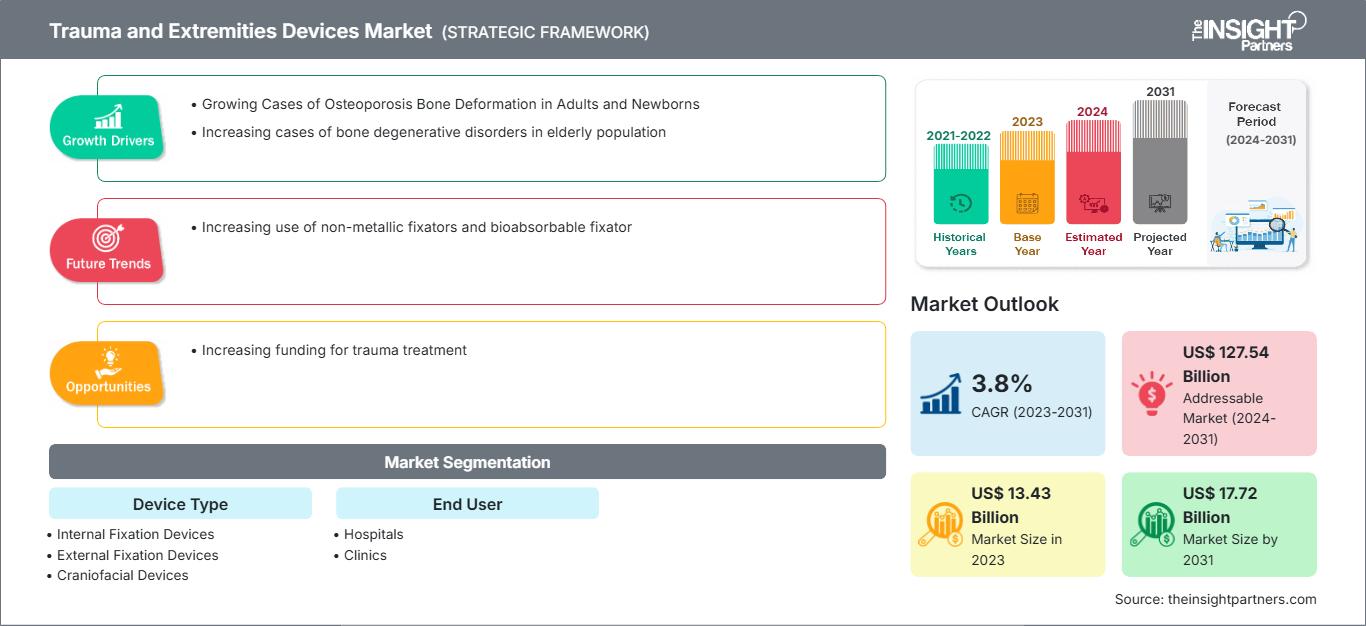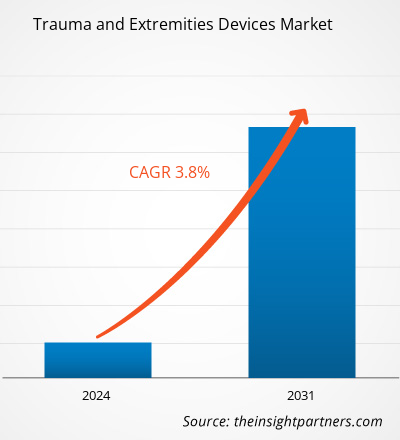Der Markt für Trauma- und Extremitätengeräte soll von 13,43 Milliarden US-Dollar im Jahr 2023 auf 17,72 Milliarden US-Dollar im Jahr 2031 anwachsen. Für den Markt wird von 2023 bis 2031 eine durchschnittliche jährliche Wachstumsrate (CAGR) von 3,8 % erwartet. Die zunehmende Verwendung nichtmetallischer und bioresorbierbarer Fixatoren bleibt voraussichtlich ein wichtiger Trend auf dem Markt für Trauma- und Extremitätengeräte.
Marktanalyse für Trauma- und Extremitätengeräte
Laut der Weltgesundheitsorganisation (WHO) sterben jährlich etwa 1,19 Millionen Menschen bei Verkehrsunfällen, und zwischen 20 und 50 Millionen Menschen erleiden nicht tödliche Verletzungen, die ihr tägliches Leben beeinträchtigen. In ähnlicher Weise veröffentlichen das indische Ministerium für Straßenverkehr und Autobahnen (MORTH) und das National Crime Records Bureau (NCRB) Schätzungen zu Verkehrsunfällen auf Grundlage von Polizeidaten. Dem Bericht zufolge wurden im Jahr 2021 fast 371.884 nicht tödliche Verkehrsunfälle gemeldet, obwohl die genannte Zahl möglicherweise zu niedrig angesetzt ist. Die steigende Zahl von Verkehrsunfällen, die zu Knochendeformationen führen, treibt somit die Nachfrage nach Trauma- und Extremitätenprodukten in die Höhe.
Marktübersicht für Trauma- und Extremitätenprodukte
Das Wachstum des Marktes für Trauma- und Extremitätenprodukte wird auf die steigende Zahl von Verkehrsunfällen mit nicht tödlichen Verletzungen und die wachsende alternde geriatrische Bevölkerung zurückgeführt, die aufgrund ihrer verringerten Knochendichte zu Knochenbrüchen neigt. Die hohen Kosten für Trauma- und Extremitätenprodukte sind jedoch ein wesentlicher Faktor, der das Marktwachstum behindert. Der globale Markt für Trauma- und Extremitätenprodukte ist regional in Nordamerika, Europa, Asien-Pazifik, Naher Osten und Afrika sowie Süd- und Mittelamerika unterteilt. In Nordamerika hatten die USA aufgrund der Präsenz wichtiger Akteure und der steigenden Zahl traumabedingter Verletzungen den größten Marktanteil. Darüber hinaus wird erwartet, dass kontinuierliche Produktentwicklungen das Wachstum des Marktes für Trauma- und Extremitätengeräte in Nordamerika ankurbeln.
Der asiatisch-pazifische Raum dürfte das schnellste Wachstum im Markt für Trauma- und Extremitätengeräte verzeichnen. Die Verbesserung der Gesundheitsversorgung und die zunehmende Zahl degenerativer Knochenerkrankungen im asiatisch-pazifischen Raum dürften das Marktwachstum weiter ankurbeln.
Passen Sie diesen Bericht Ihren Anforderungen an
Sie erhalten kostenlos Anpassungen an jedem Bericht, einschließlich Teilen dieses Berichts oder einer Analyse auf Länderebene, eines Excel-Datenpakets sowie tolle Angebote und Rabatte für Start-ups und Universitäten.
Markt für Trauma- und Extremitätengeräte: Strategische Einblicke

-
Holen Sie sich die wichtigsten Markttrends aus diesem Bericht.Dieses KOSTENLOSE Beispiel umfasst Datenanalysen, die von Markttrends bis hin zu Schätzungen und Prognosen reichen.
Markttreiber und -chancen für Trauma- und Extremitätengeräte
Zunehmende Fälle von Knochendegeneration bei älteren Menschen begünstigen den Markt
Ältere Menschen unterliegen einem höheren Sturzrisiko, und aufgrund der altersbedingten Abnutzung von Muskeln und Knochen können bereits kleinere Unfälle zu Knochenbrüchen führen. Osteoporose und andere Erkrankungen älterer Menschen können das Knochenbruchrisiko zusätzlich erhöhen. Daher korreliert ein Anstieg der älteren Bevölkerung mit der rasant steigenden Zahl orthopädischer Verletzungen und Erkrankungen, was wiederum die Nachfrage nach Trauma- und Extremitätengeräten schafft. Laut der Osteoarthritis (OA) Action Alliance sind in den USA 88 % der OA-Patienten mindestens 45 Jahre alt und 43 % 65 Jahre oder älter. Die steigende Zahl von Verkehrsunfällen treibt also die Nachfrage nach Trauma- und Extremitätengeräten in die Höhe.
Stärkung der Mittel für die Traumabehandlung – Eine Chance
Im Juli 2021 stellte die Substance Abuse and Mental Health Services Administration 62,4 Millionen US-Dollar an Zuschüssen bereit, um den Zugang zu wirksamen Behandlungs- und Dienstleistungssystemen in den USA zu ermöglichen und zu verbessern. Diese Mittel sollen Kindern, Jugendlichen und ihren Familien helfen, die traumatische Ereignisse erlebt haben. Das Weiße Haus wird außerdem zusätzliche Unterstützung in Höhe von 800.000 US-Dollar aus dem American Rescue Plan (ARP) leisten. Daher dürfte die Erhöhung der Mittel für die Traumabehandlung erhebliche Chancen auf dem Markt für Trauma- und Extremitätengeräte schaffen.
Segmentierungsanalyse des Marktberichts zu Trauma- und Extremitätengeräten
Schlüsselsegmente, die zur Ableitung der Marktanalyse für Trauma- und Extremitätengeräte beigetragen haben, sind Gerätetyp und Endbenutzer.
- Basierend auf dem Gerätetyp ist der Markt für Trauma- und Extremitätengeräte in Geräte zur internen Fixierung, Geräte zur externen Fixierung, kraniofaziale Geräte, Stimulation langer Knochen und andere segmentiert. Das Segment der internen Fixierungsgeräte hatte im Jahr 2023 den größten Marktanteil.
- Nach Endverbraucher ist der Markt in Krankenhäuser, Kliniken und andere segmentiert. Das Segment Krankenhäuser hatte im Jahr 2023 den größten Marktanteil.
Marktanteilsanalyse für Trauma- und Extremitätengeräte nach Geografie
Der geografische Umfang des Marktberichts für Trauma- und Extremitätengeräte ist hauptsächlich in fünf Regionen unterteilt: Nordamerika, Asien-Pazifik, Europa, Naher Osten und Afrika sowie Süd- und Mittelamerika.
Nordamerika dominierte den Markt für Trauma- und Extremitätengeräte. Nach Schätzungen der Centers for Disease Control and Prevention wurde zwischen 2019 und 2021 bei 21,2 % der Erwachsenen in den USA, also 53,2 Millionen Menschen, Arthritis von einem Arzt diagnostiziert. Aufgrund der steigenden Zahl degenerativer Knochenerkrankungen in der Region hatte Nordamerika im Jahr 2022 den größten Marktanteil. Die Neigung zur Entwicklung technologisch fortschrittlicher Produkte und die Präsenz globaler Marktakteure sind Faktoren, die zur Dominanz Nordamerikas auf dem Markt für Trauma- und Extremitätengeräte beitragen.
Marktnachrichten und aktuelle Entwicklungen zu Trauma- und Extremitätengeräten
Der Markt für Trauma- und Extremitätengeräte wird durch die Erhebung qualitativer und quantitativer Daten nach Primär- und Sekundärforschung bewertet, die wichtige Unternehmensveröffentlichungen, Verbandsdaten und Datenbanken umfasst. Nachfolgend finden Sie eine Liste der Entwicklungen und Strategien auf dem Markt für Trauma- und Extremitätengeräte:
- Stryker hat sein Gamma4 Hip Fracture Nailing System in den meisten europäischen Märkten eingeführt. Das neueste Gamma-System bietet Chirurgen die nächste Generation des intramedullären Nagelsystems von Stryker und ist speziell für die Behandlung von Hüft- und Femurfrakturen konzipiert. Das Gamma4-System soll die Arbeitsabläufe für Chirurgen optimieren. Im September 2023 erhielt das System die CE-Zertifizierung in Europa. (Quelle: Stryker, Pressemitteilung, 2023)
- DePuy Synthes, das Orthopädieunternehmen von Johnson & Johnson, hat das UNIUM-System als neueste Ergänzung seines Power-Tools-Portfolios auf den Markt gebracht. Das System wurde mit Fokus auf Ergonomie, Zuverlässigkeit und Effizienz im Traumabereich entwickelt. Es kann bei Eingriffen an kleinen Knochen, in der Sportmedizin sowie an der Wirbelsäule und im Thorax eingesetzt werden. (Quelle: Johnson & Johnson, Pressemitteilung, 2021)
Markt für Trauma- und Extremitätengeräte
Die Analysten von The Insight Partners haben die regionalen Trends und Faktoren, die den Markt für Trauma- und Extremitätengeräte im Prognosezeitraum beeinflussen, ausführlich erläutert. In diesem Abschnitt werden auch die Marktsegmente und die geografische Lage in Nordamerika, Europa, im asiatisch-pazifischen Raum, im Nahen Osten und Afrika sowie in Süd- und Mittelamerika erörtert.Umfang des Marktberichts zu Trauma- und Extremitätengeräten
| Berichtsattribut | Einzelheiten |
|---|---|
| Marktgröße in 2023 | US$ 13.43 Billion |
| Marktgröße nach 2031 | US$ 17.72 Billion |
| Globale CAGR (2023 - 2031) | 3.8% |
| Historische Daten | 2021-2022 |
| Prognosezeitraum | 2024-2031 |
| Abgedeckte Segmente |
By Gerätetyp
|
| Abgedeckte Regionen und Länder |
Nordamerika
|
| Marktführer und wichtige Unternehmensprofile |
|
Dichte der Marktteilnehmer für Trauma- und Extremitätengeräte: Verständnis ihrer Auswirkungen auf die Geschäftsdynamik
Der Markt für Trauma- und Extremitätenprodukte wächst rasant. Die steigende Nachfrage der Endverbraucher ist auf Faktoren wie veränderte Verbraucherpräferenzen, technologische Fortschritte und ein stärkeres Bewusstsein für die Produktvorteile zurückzuführen. Mit der steigenden Nachfrage erweitern Unternehmen ihr Angebot, entwickeln Innovationen, um den Bedürfnissen der Verbraucher gerecht zu werden, und nutzen neue Trends, was das Marktwachstum weiter ankurbelt.
- Holen Sie sich die Markt für Trauma- und Extremitätengeräte Übersicht der wichtigsten Akteure
Marktbericht zu Trauma- und Extremitätengeräten – Abdeckung und Ergebnisse
Der Bericht „Marktgröße und -prognose für Trauma- und Extremitätengeräte (2022–2030)“ bietet eine detaillierte Analyse des Marktes und deckt die folgenden Bereiche ab:
- Marktgröße und -prognose auf globaler, regionaler und Länderebene für alle abgedeckten wichtigen Marktsegmente
- Marktdynamik wie Treiber, Einschränkungen und wichtige Chancen
- Wichtige zukünftige Trends
- Detaillierte PEST- und SWOT-Analyse
- Globale und regionale Marktanalyse zu wichtigen Markttrends, Hauptakteuren, Vorschriften und aktuellen Marktentwicklungen
- Branchenlandschaft und Wettbewerbsanalyse zu Marktkonzentration, Heatmap-Analyse, prominenten Akteuren und aktuellen Entwicklungen
- Detaillierte Unternehmensprofile
- Historische Analyse (2 Jahre), Basisjahr, Prognose (7 Jahre) mit CAGR
- PEST- und SWOT-Analyse
- Marktgröße Wert/Volumen – Global, Regional, Land
- Branchen- und Wettbewerbslandschaft
- Excel-Datensatz
Aktuelle Berichte
Erfahrungsberichte
Grund zum Kauf
- Fundierte Entscheidungsfindung
- Marktdynamik verstehen
- Wettbewerbsanalyse
- Kundeneinblicke
- Marktprognosen
- Risikominimierung
- Strategische Planung
- Investitionsbegründung
- Identifizierung neuer Märkte
- Verbesserung von Marketingstrategien
- Steigerung der Betriebseffizienz
- Anpassung an regulatorische Trends






















 Kostenlose Probe anfordern für - Markt für Trauma- und Extremitätengeräte
Kostenlose Probe anfordern für - Markt für Trauma- und Extremitätengeräte